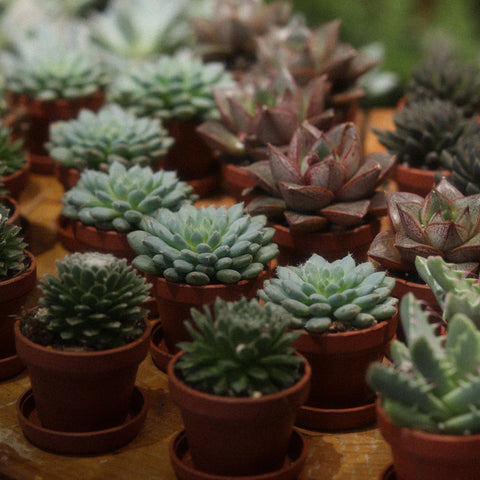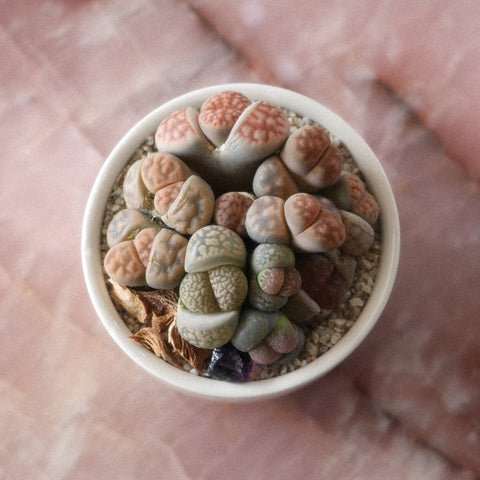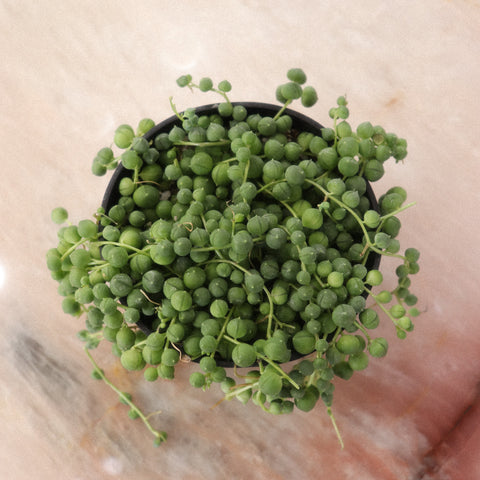HOW TO CARE FOR: SUCCULENTS
FIND CARE INSTRUCTIONS FOR SPECIFIC PLANTS AT BOTTOM OF PAGE ↓
FIND CARE INSTRUCTIONS FOR SPECIFIC PLANTS AT BOTTOM OF PAGE ↓

LIGHT
Most succulents; like cacti; are native to very arid environments. Because of this, they prefer a lot of sunlight and can tolerate periods of drought.
Place succulents in the brightest possible light within your home. A South-facing window is ideal. If these conditions cannot be achieved with natural light, introducing artificial light (a grow light) is recommended.
WATER
Allow the potting medium (soil) to dry out completely between waterings in order to prevent root rot. Once the potting mix is completely dry from top to bottom (and only then!), water thoroughly. Allow the water to soak in until the potting mix is saturated, then wait until it’s completely dry to water again.
Bottom watering (placing the plant in a dish of water and allowing its soil to soak up water through the bottom drainage hole) is an excellent method to water any succulent because the dry potting medium often prevents water absorption when top watering. This phenomena is referred to as "hydrophobic soil."
Cacti are succulents, and succulents have evolved to require a dry period. However, when it's appropriate to water, completely soak the potting mix. Recreating this rhythm of drought and downpour is key to caring for succulents - including cacti. Furthermore, watering a succulent with an ice cube or just a trickle of water will lead to stunted growth and malnutrition over time.
Watering frequency should be reduced during winter months when slower growth or dormancy occurs. Additionally, sunlight is not as intense, and the potting mix may take longer to completely dry out.
POTTING MIX
Succulents often grow in very dry, sandy environments. Use a coarse, very fast draining cacti/succulent potting mix.
You can find our house-blended potting mix here (LINK ITEM)
When repotting any succulent, including a cactus, selecting a planter with drainage (a hole in the bottom for excess water to escape) will make watering much simpler and will help the plant stay healthy.
PET SAFETY
Although succulents are generally considered non-toxic to pets, we do advise caution. Spikes are sharp. ALSO highly-toxic Euphorbia are oftentimes mislabeled as cacti/succulents because of similarities in appearance.
FOR A DETAILED LIST OF TOXIC PLANTS, VISIT THE LINK BELOW.

Lithops are native to Southern Africa. The name is derived from the Ancient Greek words λίθος (líthos), meaning "stone," and ὄψ (óps), meaning "face," referring to the stone-like appearance of the plants. They avoid being eaten by blending in with surrounding rocks!
Lithops require around 4-5 hours of direct sun; preferably in a southern-facing window. Although these plants love their sun, they can get sunburnt. Signs of this are fading colors and a bleached appearance.
The watering schedule for these plants is very important. Lithops go dormant during the winter and spring months. Lithops should be left completely dry during this time. During the growing months, your lithops will split and grow new leaves from its center. The old leaves will start to shrivel; this is part of the natural growing process and does not indicate that it is time for watering. Water your lithops once the old leaves have completely shriveled and dried up. This will allow your new leaves to absorb water and grow! This generally will align with the beginning of the summer months. Water once more in the beginning of autumn months and leave dry till the following growing season.

String of Pearls are notorious for being one of the most difficult plants to care for because there is a lot of confusion on how to care for them. These plants are native to the dry, southwest areas of Africa where they typically trail along the ground in 2'-3' strands, rooting at the nodes to create dense ground covers.
String of pearls require a lot of light. They are happiest with a lot of bright, but not direct light and can take a few hours of direct sun in the early parts of the day - an eastern or southern facing window is preferred. An important tip for growing String of Pearls is to ensure that both the top of the plant and the strands are getting a lot of light. Without light on the top, your plant will quickly thin and produce less growth.
Watering these plants is fairly simple but due to their succulent nature and shallow roots, these plants are very prone to root rot. Water your pearls roughly once every 2-3 weeks when the potting mix is completely dry. The pearls themselves hold a lot of water in them, so over watering can lead to them filling too fast and bursting. Its helpful to wait for your pearls to shrivel a little before watering again.